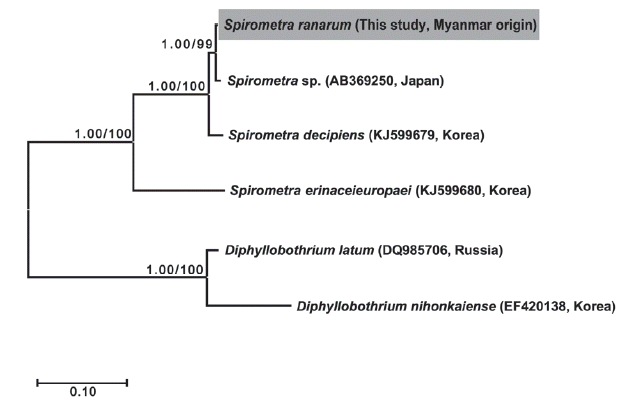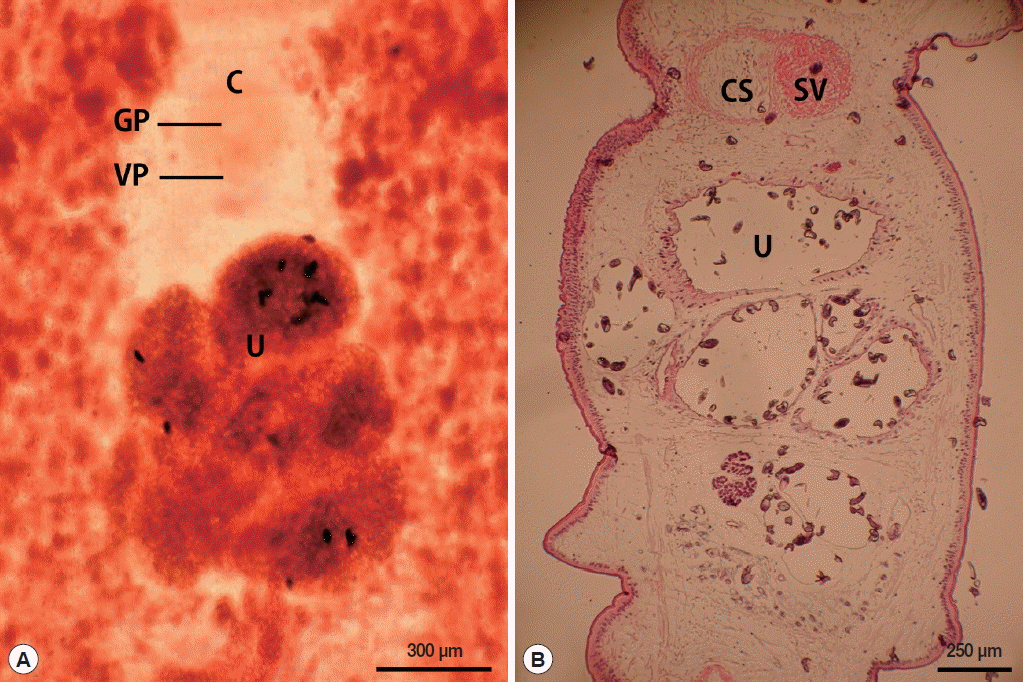1. Faust EC, Campbell HE, Kellogg CR. Morphological and biological studies on the species of
Diphyllobothrium in China. Am J Epidemiol 1929;9:560-583.

2. McIntosh A. New host records for
Diphyllobothrium mansonoides Mueller 1935. J Parasitol 1937;23:313-315.

3. Almeida GG, Coscarelli D, Melo MN, Melo AL, Pinto HA. Molecular identification of
Spirometra spp. (Cestoda: Diphyllobothriidae) in some wild animals from Brazil. Parasitol Int 2016;65:428-431.


4. Liu Q, Li MW, Wang ZD, Zhao GH, Zhu XQ. Human sparganosis, a neglected food borne zoonosis. Lancet 2015;15:1226-1235.


5. Margono SS, Sutjahyono RW, Kurniawan A, Nakao M, Mulyani T, Wandra T, Ito A. Diphyllobothriasis and sparganosis in Indonesia. Trop Med Health 2007;35:301-305.

6. Liu W, Zhao GH, Tan MY, Zeng DL, Wang KZ, Yuan ZG, Lin RQ, Zhu XQ, Liu Y. Survey of
Spirometra erinaceieuropaei spargana infection in the frog
Rana nigromaculata of the Hunan Province of China. Vet Parasitol 2010;173:152-156.


7. Liu W, Liu GH, Li F, He DS, Wang T, Sheng XF, Zeng DL, Yang FF, Liu Y. Sequence variability in three mitochondrial DNA regions of
Spirometra erinaceieuropaei spargana of human and animal health significance. J Helminthol 2012;86:271-275.


8. Zhang X, Cui J, Wei T, Li LY, Jiang J, Lu JC, Jiang P, Liu LN, Wang ZQ. Survey and genetic variation of
Spirometra erinaceieuropaei sparganum in frogs and snakes from Guangxi of southern China. Trop Biomed 2014;31:862-870.

9. Zhang X, Wang H, Cui J, Jiang P, Fu GM, Zhong K, Zhang ZF, Wang ZQ. Characterization of the relationship between
Spirometra erinaceieuropaei and
Diphyllobothrium species using complete
cytb and
cox1 genes. Infect Genet Evol 2015;35:1-8.


10. Zhang X, Wnag H, Cui J, Jiang P, Lin ML, Zhang YL, Liu RD. The phylogenetic diversity of
Spirometra erinaceieuropaei isolates from southwest China revealed by multi genes. Acta Trop 2016;156:108-114.


12. Okamoto M, Iseto S, Shibahara T, Sato MO, Wandra T, Craig PS, Ito A. Intraspecific variation of
Spirometra erinaceieuropaei and phylogenetic relationship between
Spirometra and
Diphyllobothrium inferred from mitochondrial CO1 gene sequence. Parasitol Int 2007;56:235-238.


13. Jongthawin J, Intapan PM, Sanpool O, Sadaow L, Laymanivong S, Thanchomnang T, Maleewong W. Molecular evidence of
Spirometra erinaceieuropaei infection in snakes
Ptyas korros from Lao PDR and Thailand and frogs
Hoplobatrachus rugulosus from Myanmar. Southeast Asian J Trop Med Public Health 2014;45:1271-1278.

14. Jeon HK, Park H, Lee D, Choe S, Kim KH, Huh S, Sohn WM, Chai JY, Eom KS. Human infections with
Spirometra decipiens plerocercoids identified by morphologic and genetic analyses in Korea. Korean J Parasitol 2015;53:299-305.



15. Meggitt FJ. LXXVII.—On the life history of an amphibian tapeworm (Diphyllobothrium ranarum, Gastaldi). J Nat Hist 1925;16:654-655.
16. Stamatakis A. RAxML-VI-HPC: maximum likelihood-based phylogenetic analyses with thousands of taxa and mixed models. Bioinformatics 2006;22:2688-2690.


17. Lanfear R, Calcott B, Ho SY, Guindon S. Partitionfinder: combined selection of partitioning schemes and substitution models for phylogenetic analyses. Mol Biol Evol 2012;29:1695-1701.


18. Ronquist F, Huelsenbeck JP. MrBayes 3: Bayesian phylogenetic inference under mixed models. Bioinformatics 2003;9:1572-1574.

19. Johns GC, Avise JC. A comparative summary of genetic distances in the vertebrates from the mitochondrial cytochrome b gene. Mol Bio Evol 1998;15:1481-1490.

20. Herbert PDN, Ratnasingham S, de Waard JR. Barcoding animal life: cytochrome
c oxidase subunit 1 divergences among closely related species. Proc Biol Sci 2003;270( suppl):96-99.




